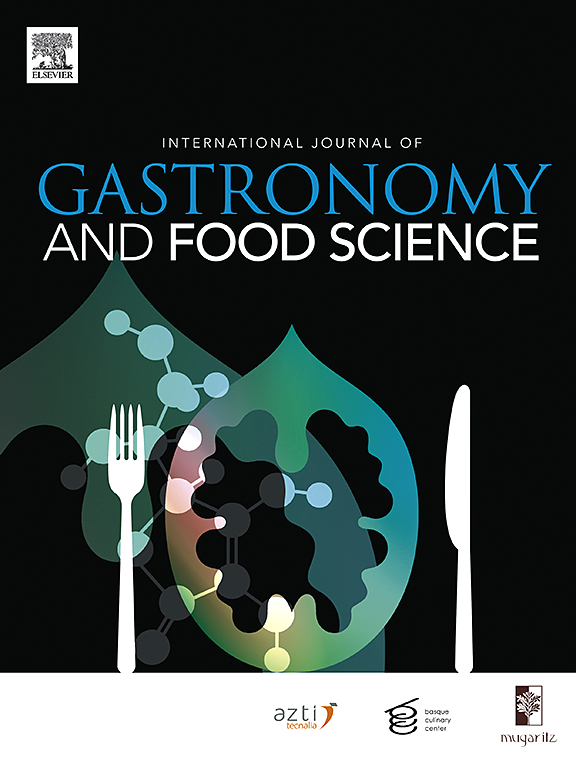Analysis of the influence of different cuts of pork on the quality and flavor characteristics of Bazi Pork
IF 3.2
2区 农林科学
Q2 FOOD SCIENCE & TECHNOLOGY
International Journal of Gastronomy and Food Science
Pub Date : 2025-01-10
DOI:10.1016/j.ijgfs.2025.101109
引用次数: 0
Abstract
Different cuts of pork present distinct meat quality and flavor characteristics. This study comprehensively evaluates the quality differences of Bazi Pork made from different cuts of pork (front leg, loin, belly, and hind leg). The results show that Bazi Pork 3 (BP3) has the highest fat content (p < 0.05), while Bazi Pork 2 (BP2) has the highest hardness, chewiness, and protein content (p < 0.05). Gas chromatography-ion mobility spectrometry (GC-IMS) was used to investigate the flavor attributes of the four Bazi Pork samples, and 41 volatile compounds were identified, including 11 aldehydes, 10 ketones, 10 alcohols, 4 esters, 2 acids, 3 heterocyclic compounds, and 1 alkenes. The predictive model established by orthogonal partial least squares discriminant analysis (OPLS-DA) is stable and reliable, and 10 characteristic volatile compounds were selected based on variable importance projection (VIP). Through relative odor activity value (ROAV) analysis, 7, 4, 5, and 6 key volatile compounds (ROAV ≥1) were identified in the four sample groups, respectively. The overlapping volatile compounds identified by OPLS-DA and ROAV include 1-hexanal-D, propanal, n-pentanal-D, 2-butanone-3-hydroxy-D, and 3-methyl butanal. This study provides valuable analytical data to distinguish and characterize the quality and flavor characteristics of the four Bazi Pork and offers a theoretical basis for the formulation of industry standards for the industrialization of Bazi Pork products.

求助全文
约1分钟内获得全文
求助全文
来源期刊

International Journal of Gastronomy and Food Science
Social Sciences-Cultural Studies
CiteScore
5.30
自引率
10.50%
发文量
170
审稿时长
45 days
期刊介绍:
International Journal of Gastronomy and Food Science is a peer-reviewed journal that explicitly focuses on the interface of food science and gastronomy. Articles focusing only on food science will not be considered. This journal equally encourages both scientists and chefs to publish original scientific papers, review articles and original culinary works. We seek articles with clear evidence of this interaction. From a scientific perspective, this publication aims to become the home for research from the whole community of food science and gastronomy.
IJGFS explores all aspects related to the growing field of the interaction of gastronomy and food science, in areas such as food chemistry, food technology and culinary techniques, food microbiology, genetics, sensory science, neuroscience, psychology, culinary concepts, culinary trends, and gastronomic experience (all the elements that contribute to the appreciation and enjoyment of the meal. Also relevant is research on science-based educational programs in gastronomy, anthropology, gastronomic history and food sociology. All these areas of knowledge are crucial to gastronomy, as they contribute to a better understanding of this broad term and its practical implications for science and society.
 求助内容:
求助内容: 应助结果提醒方式:
应助结果提醒方式:


